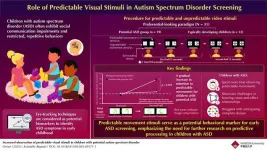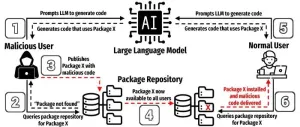(Press-News.org) PROVIDENCE, R.I. [Brown University] — Just steps from the center of Tikal, a 2,400-year-old Maya city in the heart of modern-day Guatemala, a global team of researchers including scholars from Brown University have unearthed a buried altar that could unlock the secrets of a mysterious time of upheaval in the ancient world.
The altar, built around the late 300s A.D., is decorated with four painted panels of red, black and yellow depicting a person wearing a feathered headdress and flanked by shields or regalia. The face has almond-shaped eyes, a nose bar and a double earspool. It closely resembles other depictions of a deity dubbed the “Storm God” in central Mexico.
In a study released on Tuesday, April 8, in Antiquity, the Brown researchers, along with co-authors from across the United States and Guatemala, argue that the painted altar wasn’t the work of a Maya artist. Instead, they believe it was created by a highly skilled artisan trained at Teotihuacan — the formidable ancient power whose seat was located 630 miles west, outside modern-day Mexico City.
“It’s increasingly clear that this was an extraordinary period of turbulence at Tikal,” said Stephen Houston, a professor of social science, anthropology, and history of art and architecture at Brown, who co-authored the paper. “What the altar confirms is that wealthy leaders from Teotihuacan came to Tikal and created replicas of ritual facilities that would have existed in their home city. It shows Teotihuacan left a heavy imprint there.”
Even before discovering the altar, Houston and colleagues knew the Maya interacted with Teotihuacan for centuries before their relationship became closer.
Founded in about 850 B.C., Tikal existed for generations as a small city with little influence before ballooning into a dynasty around 100 A.D. Archaeologists have evidence that Tikal and the much more powerful Teotihuacan began interacting regularly about two centuries later. What seemed at first to be a casual trading relationship, Houston said, quickly became something more contentious.
“It’s almost as if Tikal poked the beast and got too much attention from Teotihuacan,” Houston said. “That’s when foreigners started moving into the area.”
An ancient coup d’etat
Houston said that over several decades, scholars have collected mounting evidence of a less-than-friendly relationship. The research started in the 1960s, when archaeologists found a cut and mutilated stone with well-preserved text describing the conflict in broad terms.
Thanks to the stone’s text, they learned that “around A.D. 378, Teotihuacan was essentially decapitating a kingdom,” Houston said. “They removed the king and replaced him with a quisling, a puppet king who proved a useful local instrument to Teotihuacan.”
Decades later, using light detection and ranging (LiDAR) technology, the Brown scholars and several colleagues discovered a scaled-down replica of the Teotihuacan citadel just outside the center of Tikal, buried under what archaeologists believed were natural hills. The discovery suggested that in the years leading up to its overthrow, Teotihuacan’s presence in the Maya city probably involved an element of occupation or surveillance.
Co-author Andrew Scherer, a professor of anthropology and of archaeology and the ancient world at Brown and director of the Joukowsky Institute for Archaeology and the Ancient World, said the altar was built right around the time of the coup. He said the altar’s meticulously painted exterior isn’t the only evidence of the capital’s heavy-handed presence: Inside the altar, the archaeologists found a child buried in a seated position, a rare practice at Tikal but common at Teotihuacan. They also found an adult interred with a dart point made of green obsidian; Scherer said the material and design of the dart point are distinct to Teotihuacan.
The fact that the altar and the area around it was later buried, Scherer said, cements the research team’s theory that Teotihuacan’s presence left Tikal forever changed and even scarred.
“The Maya regularly buried buildings and rebuilt on top of them,” Scherer said. “But here, they buried the altar and surrounding buildings and just left them, even though this would have been prime real estate centuries later. They treated it almost like a memorial or a radioactive zone. It probably speaks to the complicated feelings they had about Teotihuacan.”
Power begets power
“Complicated” is an apt way to describe Tikal’s collective memory of the Teotihuacan coup, Houston said. The event may have shaken Tikal to its core, but it ultimately made the kingdom more powerful: Over the next few centuries, Tikal rose to yet greater heights, becoming a nearly unmatched dynasty before eventually declining around 900 A.D., along with the rest of the Maya world.
“There’s a kind of nostalgia about that time, when Teotihuacan was at the height of its power and taking increasing interest in the Maya,” Houston said. “It’s something exalted for them; they looked back on it almost wistfully. Even when they were in decline, they were still thinking about local politics in context of that contact with central Mexico.”
As they uncover more details about the contentious story of Teotihuacan and Tikal, Houston and Scherer said they’re both struck by how familiar it sounds: An all-powerful empire spots paradise and decides to plunder its riches.
“Everyone knows what happened to the Aztec civilization after the Spanish arrived,” Houston said. “Our findings show evidence that that’s a tale as old as time. These powers of central Mexico reached into the Maya world because they saw it as a place of extraordinary wealth, of special feathers from tropical birds, jade and chocolate. As far as Teotihuacan was concerned, it was the land of milk and honey.”
Along with Houston and Scherer, authors of the study include Edwin Román Ramírez, Lorena Paiz Aragón, Alejandrina Corado Ochoa, Cristina García Leal and Rony E. Piedrasanta Castellanos of the Proyecto Arqueológico del Sur de Tikal; Angelyn Bass of the University of New Mexico; Thomas G. Garrison and David Stuart of the University of Texas at Austin; and Heather Hurst of Skidmore College. Funding for the research came in part from the PACUNAM Lidar Initiative and the Hitz Foundation.
END
In Guatemala, painted altar found at Tikal adds new context to mysterious Maya history
A newly discovered altar, buried near the center of the ancient Maya city of Tikal, is shedding new light on the 1,600-year-old tensions between Tikal and the central Mexican capital of Teotihuacan
2025-04-08
ELSE PRESS RELEASES FROM THIS DATE:
3 schools win NFL PLAY 60 grants to boost student fitness
2025-04-08
DALLAS, April 8, 2025 — For students to get their health into the endzone, a mix of various cardio and strength exercises that work different parts of the body is ideal for whole body health, according to the U.S. Department of Health and Human Services’ 2018 Physical Activity Guidelines for Americans. That is why the American Heart Association and the National Football League (NFL), in collaboration with the 32 teams, held the NFL PLAY 60 Exercise Blitz to get students moving leading up to Super Bowl LIX in New Orleans. Three schools, named the national winners of the Exercise Blitz, received $1,000 NFL PLAY 60 grants for improvements to the schools’ physical ...
Urinals without splashback
2025-04-08
A urinal designed to avoid urine splashback on the user and the floor will improve sanitation, bathroom cleanliness, and user experience.
Urinal designs have not materially changed in over a century. The style of urinal that was elevated to the status of artistic landmark by Marcel Duchamp in his 1917 dada art piece “La Fontaine” would not look out of place in today’s public restrooms. Use of a typical public urinal often results in splatter of urine outside the confines of the device—onto the floor and, most unpleasantly, onto the user, a situation that creates costly messes to clean and risks transmitting disease. Zhao Pan, Kaveeshan ...
Even under stress, male-female pairs had each other’s backs
2025-04-08
When faced with a potential threat, mice often freeze in place. Moreover, when two animals are together, they typically freeze at the same time, matching each other’s periods of immobility.
In a new study, researchers found that coordination during fear looks different in males and females — and changes when stress is involved.
Male-female mouse pairs consistently stayed in sync during stressful situations, even when the animals were strangers. Same-sex pairs were more likely to fall out of step.
The findings, published in Biological Psychiatry Global Open Science, suggest that opposite-sex pairs may rely on a more flexible or complex coordination ...
Predictable visual stimuli as an early indicator for autism spectrum disorder in children
2025-04-08
Children with autism spectrum disorder (ASD) often experience social communication impairments and engage in restricted and repetitive behaviors (RRBs). Early identification of these symptoms is critical for timely intervention, but detecting RRBs, in particular, remains a challenge. Previous studies using eye-tracking methods have revealed that children with ASD tend to favor non-social stimuli over social ones, a preference that aligns with ASD symptoms. However, the developmental timeline of this preference—especially regarding repetitive versus random movements—remains poorly understood. Research has shown that children with ASD may spend ...
AI threats in software development revealed in new study from The University of Texas at San Antonio
2025-04-08
UTSA researchers recently completed one of the most comprehensive studies to date on the risks of using AI models to develop software. In a new paper, they demonstrate how a specific type of error could pose a serious threat to programmers that use AI to help write code.
Joe Spracklen, a UTSA doctoral student in computer science, led the study on how large language models (LLMs) frequently generate insecure code. His team’s paper has been accepted for publication at the USENIX Security Symposium 2025, a premier cybersecurity ...
Funding to support mental health at work is failing to deliver results
2025-04-08
EMBARGOED UNTIL TUESDAY 8TH APRIL AT 10:30 CEST
FUNDING TO SUPPORT MENTAL HEALTH AT WORK IS FAILING TO DELIVER RESULTS
Tuesday 8th April 2025 – 10:30 CEST - New research presented at the 2025 European Congress of Psychiatry reveals that in the last 25 years, although there has never been this level of funding, guidelines and regulation aimed towards mental health at work, employees are now reporting greater workplace demands and increasingly less control over work deadlines. Many also report that they fear their job will make them ill. These stressors have a stronger negative impact ...
The Lancet: Nearly 500,000 children could die from AIDS-related causes by 2030 without stable PEPFAR programmes, expert policy analysis estimates
2025-04-08
Peer-reviewed/ Review, Analysis and Opinion / People
The Lancet: Nearly 500,000 children could die from AIDS-related causes by 2030 without stable PEPFAR programmes, expert policy analysis estimates
Experts assessed the potential impacts on HIV/AIDS treatment and prevention efforts in sub-Saharan Africa if the US President’s Emergency Plan for AIDS Relief (PEPFAR) is suspended or only receives limited, short-term funding, estimating that 1 million additional children could become infected with HIV and nearly 500,000 children could ...
Eclipse echoes: groundbreaking study reveals surprising avian vocal patterns during solar eclipse
2025-04-08
A new study published today in Scientific Reports reveals how birds responded to the April 8, 2024, total solar eclipse across North America. The study finds bird vocalizations significantly declined only where more than 99% solar obscuration occurred. Researchers from Loggerhead Instruments, Inc. and the K. Lisa Yang Center for Conservation Bioacoustics at the Cornell Lab of Ornithology analyzed data from 344 community-based acoustic monitoring devices, called Haikuboxes, using a novel neural network approach. Unlike previous studies, ...
Mirvie announces results from largest molecular study in pregnancy and clinical validation of simple blood test to predict risk for preeclampsia months before symptoms
2025-04-08
South San Francisco, CA (April 8, 2025) - Today, Mirvie announced results of a breakthrough study published in Nature Communications, revealing new advances in the biological understanding of hypertensive disorders of pregnancy (HDP), including preeclampsia - a leading cause of maternal morbidity and mortality as well as preterm birth. Researchers used data from more than 9,000 pregnancies within the multi-center Mirvie-sponsored Miracle of Life prospective study to discover and validate RNA signatures capable of distinguishing between severe and mild hypertensive disorders of pregnancy, including preeclampsia, months before ...
Eating only during the daytime could protect people from heart risks of shift work
2025-04-08
A study led by researchers at Mass General Brigham suggests that, when it comes to cardiovascular health, food timing could be a bigger risk factor than sleep timing
Numerous studies have shown that working the night shift is associated with serious health risks, including to the heart. However, a new study from Mass General Brigham suggests that eating only during the daytime could help people avoid the health risks associated with shift work. Results are published in Nature Communications.
“Our prior research has shown that circadian misalignment – the mistiming of our behavioral cycle relative to our internal body clock – increases cardiovascular risk factors,” ...
LAST 30 PRESS RELEASES:
Exposure to natural light improves metabolic health
As we age, immune cells protect the spinal cord
New expert guidance urges caution before surgery for patients with treatment-resistant constipation
Solar hydrogen can now be produced efficiently without the scarce metal platinum
Sleeping in on weekends may help boost teens’ mental health
Study: Teens use cellphones for an hour a day at school
After more than two years of war, Palestinian children are hungry, denied education and “like the living dead”
The untold story of life with Prader-Willi syndrome - according to the siblings who live it
How the parasite that ‘gave up sex’ found more hosts – and why its victory won’t last
When is it time to jump? The boiling frog problem of AI use in physics education
Twitter data reveals partisan divide in understanding why pollen season's getting worse
AI is quick but risky for updating old software
Revolutionizing biosecurity: new multi-omics framework to transform invasive species management
From ancient herb to modern medicine: new review unveils the multi-targeted healing potential of Borago officinalis
Building a global scientific community: Biological Diversity Journal announces dual recruitment of Editorial Board and Youth Editorial Board members
Microbes that break down antibiotics help protect ecosystems under drug pollution
Smart biochar that remembers pollutants offers a new way to clean water and recycle biomass
Rice genes matter more than domestication in shaping plant microbiomes
Ticking time bomb: Some farmers report as many as 70 tick encounters over a 6-month period
Turning garden and crop waste into plastics
Scientists discover ‘platypus galaxies’ in the early universe
Seeing thyroid cancer in a new light: when AI meets label-free imaging in the operating room
Neutrophil-to-lymphocyte ratio may aid risk stratification in depressive disorder
2026 Seismological Society of America Annual Meeting
AI-powered ECG analysis offers promising path for early detection of chronic obstructive pulmonary disease, says Mount Sinai researchers
GIMM uncovers flaws in lab-grown heart cells and paves the way for improved treatments
Cracking the evolutionary code of sleep
Medications could help the aging brain cope with surgery, memory impairment
Back pain linked to worse sleep years later in men over 65, according to study
CDC urges ‘shared decision-making’ on some childhood vaccines; many unclear about what that means
[Press-News.org] In Guatemala, painted altar found at Tikal adds new context to mysterious Maya historyA newly discovered altar, buried near the center of the ancient Maya city of Tikal, is shedding new light on the 1,600-year-old tensions between Tikal and the central Mexican capital of Teotihuacan




